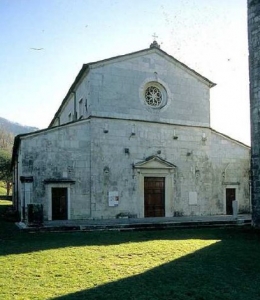
Information
Foundation:
VIII century
District/Location:
Seravezza
District:
Versilia


This old church used to be preceded by a portico (destroyed during the Second World War) that is linked to Michelangelo. The 17th and 18th century interior is also remarkable.
Seravezza
First recorded in 721, as dependent on the Parish Church of Vallecchia, it was granted it own christening font and jurisdiction over the villages in the surrounding hills that made up the Community of the Cappella in 1299. Having previously always been part of the diocese of Luni-Sarzana, in 1789 it was detached and assigned to that of Pisa, where it still remains today.
Despite numerous alterations over time, the present building still features characteristic elements of the austere medieval architecture in the Lucca area. In the early 16th century a portico and rose window, called “the eye of Michelangelo”, were added, both connected to the presence of the Buonarroti in this area.
It is a historically accepted fact that Michelangelo stayed in this area in the early 16th century as supervisor of the transport of marble destined for Pope Leone X Medici, making it possible that he had an influence on the realization of the portico by Donato Benti. Destroyed during the Second World War, the only remaining evidence of the portico is limited to photographs, which however testify to its constituting a unique example of Renaissance architecture in the area.
The numerous renovations over time also led to the addition of a ciborium with polychrome marble tempiettos by Davide Tedeschi in the late 16th century, and a number of important pieces, including a christening font, new high-altar and pulpit, in the 17th century.
The church also holds traces of its original interior, including a 14th century capital, a terricolous memorial tablet and a Eucharistic shrine.
The remains of a large fresco, featuring Christ bearing the cross and pouring blood in the chalice, are also of interest. This is an extremely rare example of an iconographic model in Versilia documented in the shrines of Donato Benti.
Despite numerous alterations over time, the present building still features characteristic elements of the austere medieval architecture in the Lucca area. In the early 16th century a portico and rose window, called “the eye of Michelangelo”, were added, both connected to the presence of the Buonarroti in this area.
It is a historically accepted fact that Michelangelo stayed in this area in the early 16th century as supervisor of the transport of marble destined for Pope Leone X Medici, making it possible that he had an influence on the realization of the portico by Donato Benti. Destroyed during the Second World War, the only remaining evidence of the portico is limited to photographs, which however testify to its constituting a unique example of Renaissance architecture in the area.
The numerous renovations over time also led to the addition of a ciborium with polychrome marble tempiettos by Davide Tedeschi in the late 16th century, and a number of important pieces, including a christening font, new high-altar and pulpit, in the 17th century.
The church also holds traces of its original interior, including a 14th century capital, a terricolous memorial tablet and a Eucharistic shrine.
The remains of a large fresco, featuring Christ bearing the cross and pouring blood in the chalice, are also of interest. This is an extremely rare example of an iconographic model in Versilia documented in the shrines of Donato Benti.
Scopri altre attrazioni vicino a Saint Martino in Seravezza
See allYou may also like..
See allFind more
0











